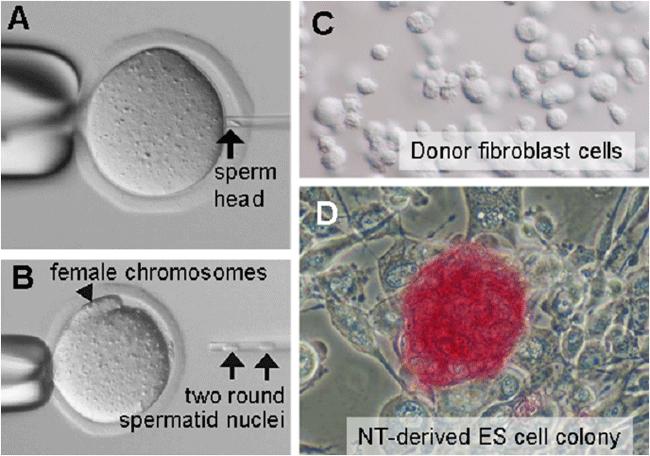 |
BRC Current Technology November 2013 |
8. Generation of ES cells by ICSI or nuclear transferFor strain conservation and biomedical research use
|
In mice, it is technically easy to generate embryos by intracytoplasmic sperm injection (ICSI) or nuclear transfer (NT) cloning. Blastocysts that develop from these ICSI- or NT-derived embryos can give rise to embryonic stem (ES) cells, which inherit some genetic and epigenetic features from the parental germ cells or donor cells. By ICSI (A in figure), hybrid F1 ES cells between a laboratory strain and a wild-derived strain were generated for (epi)genetic analysis based on the parental allelic polymorphism such as genomic imprinting [1]. In combination with ICSI (injection of two round spermatids, B in figure) and enucleation technique, diploid androgenetic embryos carrying allelic polymorphism can also be generated [2]. NT-derived embryos enable us to generate ES cells, which are the exact genetic copies of the donor cells (C and D in figure). Therefore, they may be used as the cell-based backups of the mouse genetic resources [3]. ES cells derived from lymphocytes inherit the DNA rearrangement pattern from the donor lymphocytes and may provide a unique research resource for immunological studies [4]. Thus, ICSI and NT, which were originally developed as assisted reproductive techniques, can also be used for generation of a variety of ES cells for strain conservation and biomedical researches. |
| References: |
| [1] Shinmen et al. Mol Reprod Dev 74:1081-1088, 2007 |
| [2] Miki et al. Genesis 47:155-160, 2009 |
| [3] Wakayama et al. Science. 292:740-743, 2001. |
| [4] Inoue et al. Curr Biol 15:1114-1118, 2005. |
| ICSI- or NT-derived ES cell lines distributed from RIKEN BRC (Cell Bank) |
| (C57BL/6 x MSM/Ms)F1 ES cell lines: AES0131, AES0132, AES0133 | (C57BL/6 x JF1/Ms)F1 androgenetic ES cell lines: AES0147, AES0148, AES0149 |
| Somatic cell NT ES cell lines: AES0012 and others |
| T-cell derived NT ES cell line: AES0127 |





